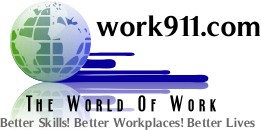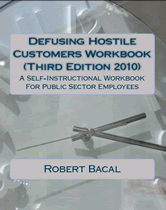
Technology & Productivity--Why We Get One Without The Other
Over the last few years we have experienced a proliferation of technology in government offices. It is not uncommon to find computers on many desks, and fax machines, answering machines, voice mail systems and other assorted hardware.
Technology is certainly changing the way we do things. Whether technology is resulting in increased productivity is a question that is often left unanswered. Perhaps one reason that it is not actively explored is that the answer is not one we want to contemplate.
Research indicates that productivity in non-white collar jobs has increased with the advent of improved technology. Research has also found that white-collar productivity HAS NOT increased in a similar way. Technology does not appear to have brought the same improvements in office contexts as it has in anufacturing. Some of these finding might be explained by inadequate measurement--it's harder to measure productivity in white collar positions. However, it is also the case that we just aren't very good at squeezing out the productivity enhancement potential that is inherent in technology. Technology, in itself, is not sufficient to produce improvement.
If
you are working in a setting that has increased its use of computers,
it is important that you understand why productivity increases
do not automatically follow on the heels of using the equipment.
Why Technological Changes Don't Always Help
There
are a number of reasons...probably too many to cover here, but
we can look at some important ones.
Limits From Other Government Processes -- Lack of Integration
If you were to implement a computerized accounting system in your branch, you would normally expect that it would take less time to manage and control your budget. This may not turn out to be the case, if there are requirements and processes that you must follow that come from your division, branch, or the Finance Department. While your system may reduce time needed to serve your internal needs, it may, in fact, require more time to meet the needs of those outside your immediate organization.
For
example, when I was with the Organization & Staff Development
Branch, I lead a team whose purpose was to automate the
course registration procedure. Part of the registration
process involved tracking, billing and accounting.
The system that was developed could be used in "paperless"
mode. In other words, there was a potential to eliminate
application forms completely, and the filing and accounting
systems linked to these forms. However, we discovered that
the overall financial system required that the application
forms, duly signed and authorized, were
needed to process the inter-departmental transfers of funds.
The result was that the filing of paper, copying of forms, etc were required, thus limiting the savings of time that would otherwise have been achieved.
The point here is that your procedures, you computers, do not exist in isolation from other systems, or regulations that exist in government.
One
more quick example. Some branches have implemented electronic
mail systems internally, allowing staff to send messages
to each other without using paper. Productivity, however,
is reduced because it is necessary to keep the structure
to process paper in place, since there are many people, particularly
outside these branches, that do not have this facility.
In addition, you have the conundrum of Freedom of Information
an archiving procedures that are designed to work with paper-based
systems.
Productivity Goes Unmeasured, Problems Go Unnoticed
There
is a tendency to take productivity improvements for granted, and
it is very rare to find organizations that bother to evaluate
whether their spiffy new automated process really increases
productivity. In itself this might not be a problem but
for the fact that "glitches" in the automated process may
go unnoticed. Without measuring productivity after technological
innovation, it is
difficult to identify where the new system is not working as desired--and
difficult to improve it continuously.
Poor Initial Decision-Making
Often, in government, the purchase of equipment, or software, is not undertaken with very much diligence. The decisions to proceed with technological undertakings are made with only a very vague conception of how the technology will improve things. In fact, it is not uncommon to find that the decision to automate is made, and then people in the organization scramble to justify the decision, as opposed to examining if it is the right decision. Business case justifications, required by some agencies, are no solution because it is almost always be feasible to "cook up" figures that will show acceptable cost recoveries. I know. I wrote a few of these documents.
The
point here is that automation and the application of technology
should not be undertaken because "everyone is doing it",
or "isn't that neat". A comprehensive and real analysis
needs to be done prior to making the decision rather than
the ass-backwards process of deciding and justifying. The
only way you will receive productivity improvements is if the
INITIAL decisions are based on the notion that technology can
provide solutions to problems, but that the problems must be specified
FIRST.
Technology Without Skill Enhancement
Productivity
occurs as a result of interaction between people and machines,
not from the availability of machines. As such productivity
improvements will only occur if the users of the technology
are willing to upgrade their own skills.
Most people are aware that technology users need to know what buttons to push to make it work. So, there will often be some opportunity to attend courses in using specific software--databases, spreadsheets and word processors. What is often forgotten is the need for supplementary skills.
It is very common for executives or managers to have computers on their desks to be used for word processing. On the surface, it makes sense for managers, in some contexts, to do their own correspondence. How many of those managers know how to type? Or how to format a business letter? What happens then is that the potential for savings is lost if the person lacks the skills to "actualize" the savings.
As another example, the advent of desktop publishing programs permits people to produce very fancy documents "in-house". However, while a person may be able to push the right buttons, there is no guarantee that the person will have the required skills in page layout and graphic design. The result: lost productivity, as things need to get re-done.
The Nature of Technologies
last area we can look at is the capability of technology. Computers allow us to do different things, to process more information, and can change who does what. The manager can easily do his or her own correspondence, promotional material need not be sent to experts for production.
When we implement technology we generally hope that it will allow us to do things more efficiently. We don't often realize that the application of technology will push us to collect more information, rather than simply manipulate our current information available. Work expands to meet the capabilities of the technology. So, while you may end up doing some different things, you may not end up working less.
These are just a few reasons why technology doesn't automatically result in better productivity. There are many more, and we will come back to them in future issues.





